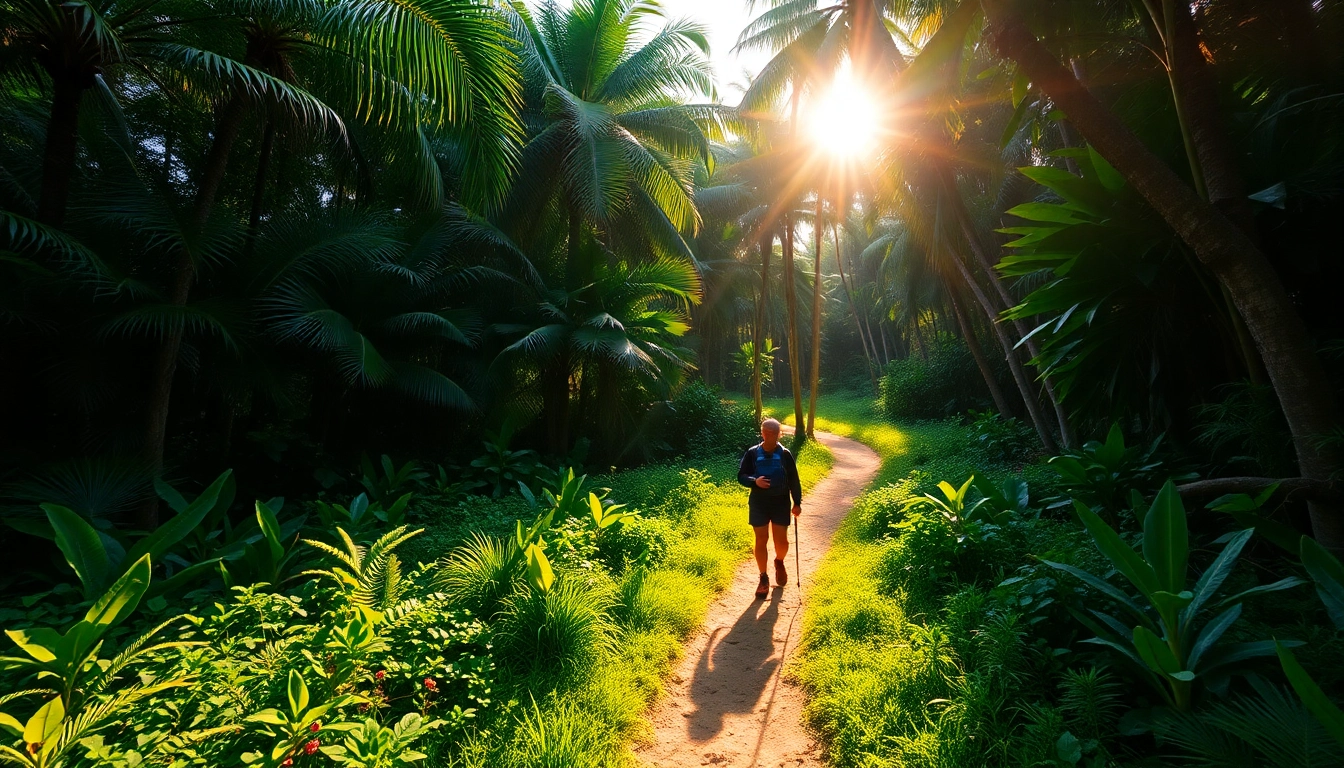Understanding the Basics of Hiking: Definitions and Types
What is Hiking? Key Concepts and Benefits
Hiking is a popular outdoor activity that involves walking along designated trails or natural landscapes for recreation, exercise, or exploration. Unlike casual strolling, hiking typically encompasses a vigorous walk that traverses varying terrains such as mountains, forests, and rural pathways. its roots trace back to European outdoor traditions in the 18th century, evolving into a worldwide practice embraced for health, leisure, and environmental appreciation. For enthusiasts and beginners alike, understanding the core concepts of hiking allows for a more enriching and safe experience. Consciously engaging with nature not only provides physical benefits but also offers mental clarity and emotional relaxation.
To deepen your understanding, explore more about hiking and how it differs from other outdoor activities. The benefits are extensive, including cardiovascular health, muscle strengthening, stress reduction, and an overall boost to mental well-being. This holistic exposure to nature fosters a sense of achievement and connection that is increasingly vital in today’s fast-paced world.
Different Types of Hiking Activities in Indonesia
Indonesia, with its vast archipelago and diverse landscapes, offers a multitude of hiking experiences tailored for various skill levels and interests. Popular styles include:
- Day Hiking: Short trips typically lasting a few hours, suitable for beginners or those with limited time, exploring local forests, waterfalls, or mountain foothills.
- Backpacking: Multi-day adventures involving camping overnight in remote areas, allowing hikers to immerse fully in nature while covering significant distances.
- Trail Hiking: Walking on established paths within national parks like Gunung Rinjani or Komodo Island, known for stunning vistas and unique fauna.
- Altitude Hiking: Ascending higher elevations such as the peaks of Mount Semeru or Mount Rinjani, demanding physical endurance and proper preparation.
- Cultural Trekking: Combining hikes with visits to local villages and cultural sites, enriching the outdoor experience with historical insights.
Whether you seek a leisurely walk in lush jungles or an imposing climb to a volcanic summit, Indonesia’s terrains offer opportunities to experience nature’s grandeur uniquely.
Hiking vs Trekking: What’s the Difference?
Many confuse hiking with trekking, but understanding the distinction enhances planning and safety. Hiking generally refers to walking on well-marked trails, often within national parks or nature reserves, typically lasting a few hours or a day. It involves moderate effort, with the primary goal of leisure, exercise, or sightseeing. On the other hand, trekking involves multi-day journeys into more remote, rugged, and less accessible terrains, often requiring overnight stays, camping, and carrying substantial gear. Trekking demands higher endurance, more detailed planning, and specialized skills.
For example, a day hike up Mount Rinjani on Lombok might involve a 6-8 hour trek with prepared supplies, while an extended trek could span several days across the island’s interior, involving steep climbs and unpredictable weather. The key takeaway is that trekking challenges the hiker’s resilience and logistical planning more than typical hiking routes.
Preparing for a Memorable Hiking Adventure
Essential Gear and Equipment for Indonesian Trails
Proper preparation begins with selecting the right gear tailored to the terrain and weather conditions in Indonesia. Essential items include:
- Footwear: Durable hiking boots with ankle support and good grip for muddy or rocky paths.
- Clothing: Moisture-wicking layers, lightweight waterproof jackets, and thermal wear for varying climates.
- Backpack: A comfortable, appropriately-sized pack to carry essentials like water, snacks, and extra layers.
- Navigation Tools: GPS device, compass, and detailed maps to avoid getting lost, especially in less-marked trails.
- Safety Items: First aid kit, multi-tool, whistle, and headlamp or torch for emergencies.
- Eco-friendly Supplies: Reusable water bottles, trash bags, and biodegradable hygiene products to adhere to leave no trace principles.
Ensuring your gear is suitable for Indonesia’s climatic conditions—ranging from tropical heat to mountain cold—is crucial for safety and comfort.
Planning Your Route: Popular Hiking Destinations in Lombok
Lombok is renowned for its stunning volcanic landscapes, pristine beaches, and vibrant culture. Notable hiking destinations include:
- Mount Rinjani: Indonesia’s second-highest peak, offering challenging multi-day treks with breathtaking views and a crater lake.
- Mount Tambora: Historic volcano with an accessible summit trek, providing stunning panoramic vistas and rich geological history.
- Benang Stokal and Benang Kelambu Waterfalls: Easy to moderate hikes featuring lush rainforests and cascading waterfalls perfect for day trips.
When planning, consider seasonal weather patterns, trail conditions, and required permits to ensure a smooth adventure.
Safety Tips and Best Practices for Hiking Beginners
Beginners should prioritize safety by:
- Informing someone about your plan and estimated return time.
- Starting with shorter, well-marked trails before progressing to more challenging routes.
- Checking weather forecasts and avoiding hikes during adverse conditions.
- Remaining on designated trails to protect both yourself and the environment.
- Carrying sufficient water and snacks to stay energized and hydrated.
- Keeping a calm attitude and knowing basic first aid procedures.
Always be prepared to turn back if conditions deteriorate or if you feel physically unwell.
Enhancing Your Hiking Experience
Proper Nutrition and Hydration on the Trail
Maintaining energy during hikes involves consuming balanced snacks such as nuts, dried fruits, energy bars, and staying hydrated with clean water. Dehydration is a common hazard, especially in tropical climates like Indonesia’s, which emphasizes the need for carrying sufficient water and knowing how to purify natural sources if necessary. Incorporate electrolytes to replenish lost minerals, and avoid alcohol or caffeine, which can lead to dehydration.
Leave No Trace: Responsible Hiking Etiquette
Preserving Indonesia’s pristine landscapes demands responsible outdoor conduct. Follow Leave No Trace principles:
- Pack out all trash and waste.
- Respect wildlife and plant life by not disturbing habitats.
- Stay on established trails to prevent erosion and habitat destruction.
- Minimize campfire impact and ensure fires are fully extinguished.
- Be considerate of other hikers by keeping noise levels low.
Practicing environmentally friendly habits ensures future generations can enjoy these natural wonders.
Capturing Memories: Photography Tips for Hikers
Nature offers spectacular opportunities for photography. To capture stunning images:
- Time your shots during the golden hour—early morning or late afternoon—for optimal lighting.
- Use a wide-angle lens to encompass vast landscapes.
- Remove unnecessary clutter from the shot for better composition.
- Secure your camera to avoid blurring on uneven terrain.
- Experiment with different angles and perspectives to highlight natural features.
Remember to respect nature’s tranquility and minimize your footprint while capturing memories.
Health Benefits and Long-term Rewards of Hiking
Physical and Mental Health Benefits in Outdoor Activities
Hiking is a comprehensive workout that benefits cardiovascular health, muscle strength, flexibility, and endurance. Regular activity reduces risks of chronic diseases like hypertension, diabetes, and obesity. Beyond physical benefits, outdoor hiking stimulates mental health by reducing stress, anxiety, and depression. The exposure to natural environments has been proven to improve mood, boost creativity, and promote better sleep patterns. The rhythmic nature of walking combined with scenic views fosters mindfulness and emotional resilience.
Building Confidence and Connecting with Nature
Successfully conquering challenging terrains fosters self-confidence and resilience. Engaging with diverse ecosystems, observing wildlife, and summiting peaks cultivate a sense of achievement. This connection deepens appreciation for nature’s delicate balance, encouraging sustainable habits and inspiring environmental stewardship.
Incorporating Hiking into Your Lifestyle
To embed hiking into daily routines:
- Join local hiking groups or clubs for social motivation.
- Schedule regular weekend hikes, gradually increasing distance and difficulty.
- Use hiking as a family activity to promote healthy habits early.
- Set personal goals, such as conquering new trails or improving pace.
The cumulative benefits support long-term health, well-being, and ecological awareness.
Advanced Tips for Experienced Hikers
Navigation Skills and Using Trail Maps
Mastering navigation is vital for exploring off-the-beaten-path areas safely. Familiarize yourself with reading topographic maps and using GPS devices. Practice compass techniques and route planning before embarking on complex trails. Understanding the terrain and trail markers reduces dependence on electronic devices, especially in remote areas with limited signal.
Weather Awareness and Adaptability
Indonesia’s tropical mountain weather can shift rapidly. Rainforests may experience sudden downpours; mountain summits can encounter cold and fog. Always check forecasts, pack rain gear, and be prepared to adjust or abandon plans when necessary. Recognizing signs of weather deterioration ensures safety and conserves energy.
Training Programs to Boost Endurance and Performance
Enhance your hiking efficiency through targeted training: incorporate cardiovascular workouts, stair climbing, strength training, and flexibility exercises. Gradually increase hike durations and elevations to adapt to higher demands. Cross-training activities like cycling and swimming complement endurance building. Regular training translates into more enjoyable, safer, and more rewarding hikes.

